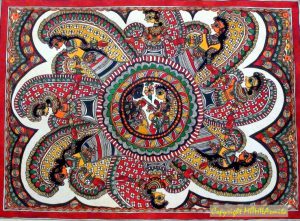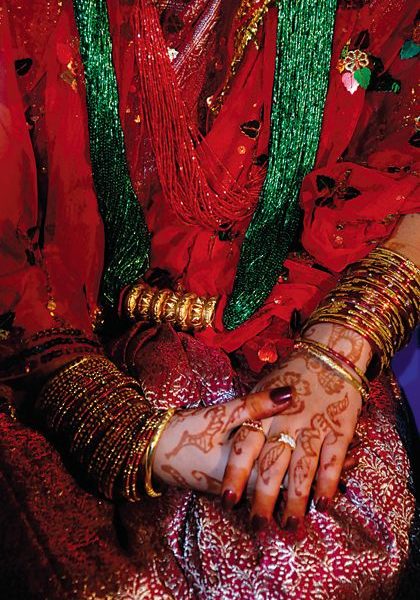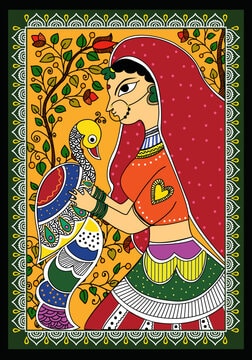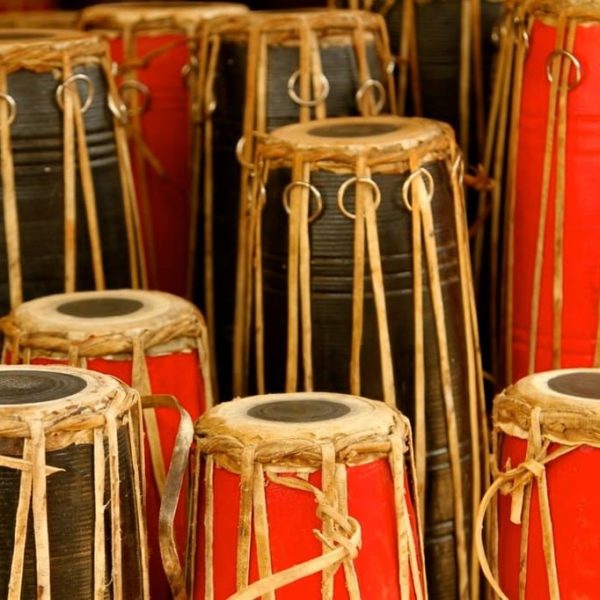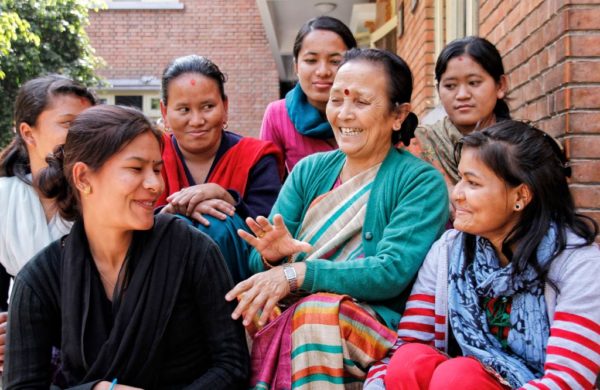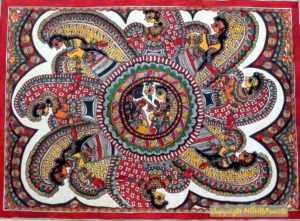
The dazzling Mithila artwork produced by Maithili women of Nepal can be traced back as far as the 7th century and has been passed from generation to generation since. Mithila painting also known as Madhubani art or painting in India is a traditionally designed painting created by the women of various communities in the Mithila region of Nepal and India. As the former capital of the kingdom of Mithila, Janakpur has emerged as the center for both preserving and promoting this ancient art.
Initially, the womenfolk of the village drew the paintings on the walls of their home, with fingers, twigs, brushes, and matchsticks as an illustration of their thoughts, hopes, and dreams. With the change in time and tradition, the paintings started becoming a part of festivities and special events, like marriage. Slowly and gradually, the Mithila painting starts developing on paper and canvas crossing the traditional boundaries and started reaching connoisseurs of art, both at the national as well as the international level.
Ancient History and Myths of Mithila Art

The representative form of Mithila art has its origin in the great Indian sub-continental epic Ramayana where it is believed King Janaka of Mithila hired local artists and decorated the town of Janakpur with this unique art form for the wedding of his daughter Sita to Rama.
“In the following we see that Mithila Art is wedded to the concept of democracy from a very early period, predating by millennia the emergence of modern democracy — this background and context has special significance for Mithila Art’s most internationally renowned characteristic: women’s empowerment, itself one of the fundamental strands of modern democracy and related egalitarian values as seen through gender equality.”
What’s so special about Mithila art?

Traditionally, the painting was one of the skills that were passed down from generation to generation in the families of the Mithila Region, mainly by women. Different variants of Mithila paintings were done on walls coated with mud and cow dung, nevertheless, it never lacked precision in bringing to fore the symbolic representation, which effectively gives it its uniqueness.
When technically evaluating, Mithila paintings can be divided into five distinctive styles: Bharni, Kachni, Tantrik, Nepali, and Gobar. Until the 1960s, when Mithila paintings were not yet commercialized, Bharni, Kachni, and Tantrik style were mainly done by Brahman and Kayashth women, who are the upper caste women in Nepal and India.
Mithila paintings mostly portray the men, its association with nature and the scenes deity from the ancient epics. Natural objects like the sun, the moon, and religious plants like tulsi are also widely painted, along with scenes from the royal court and social events like weddings. Generally, no space is left empty; the gaps are filled by paintings of flowers, animals, birds, and even geometric designs. It is still practiced and kept alive in the institutions spread across the Mithila region.
Done in primary colors of natural origin on paper and cloth, the Mithila Art narrates mythological and religious events. The Painting is done with fingers, twigs, brushes, nib-pens, and matchsticks, using natural dyes, and pigments, and is characterized by eye-catching geometrical patterns.
Widely used Mithila images include deities such as Vishnu, Ganesh, Radha, Krishna, Sita, and Ram. There is ritual content for particular occasions, such as birth or marriage, and festivals, such as Holi, Surya Shasti, Kali Puja, Upanayana, Durga Puja.
Colors used in Mithila Art
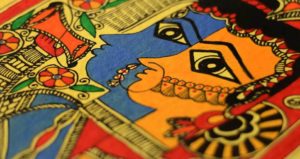
The women artists of Mithila use different local colors in their art. Generally, they use bright and brilliant colors which make their arts very pretty and at the same time very attractive. They use bright red, yellow and black colors. These three colors are frequently used which are very natural such as black is from soot, red from local clay and yellow from petals of flowers or turmeric.
They use indigenous colors in their art to make them attractive and lasting. They prepare vegetable colors from different flowers, fruits, barks, and root. The gum prepared naturally from the babul tree is mixed in the colors for durability. Black is generally obtained by lamp spot. It is easily dissolved in gum water. A light color is obtained by mixing cow-dung and gum in fresh water. The bark of the peepal tree is dried in the sunrise and then boiled in water until it yields a pink color. The blue color is obtained by crushing the berries of the wild herb. These colors are used to their imagination and vision. They also sometimes use watercolor mixed with rice powder (which is called pithar in local language) and vermillion (sindur in local language).
Mithila Art – Going places
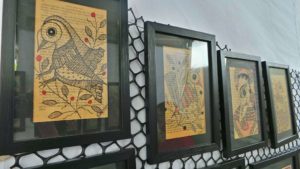
Bharati Dayal, an artist from India a keen practitioner of Madhubani painting, features divine forms and narratives in her works. She offers her creative repository to art enthusiasts through this elegantly produced book. This book showcases some of the best paintings of Bharati Dayal and re-confirms that she is an artist who has indeed played a significant role in the re-emergence and spread of this ethnic art form. Her paintings get completed in a diversely rich combination of graphic designs, tattoos, lines, concentric circles, motifs of flora and fauna, spirits and animistic renderings—exuding figurative intents.
Furthermore, the Maithils are Shakti (mother goddess) worshippers—and the schools of Tantric rituals have been flourishing in their surroundings, giving spiritual traction to an informal art form that soon became a living tradition.
One of the best-known social projects is the Janakpur Women’s Development Centre, just south of the city in the village of Kuwa. Around 40 Maithili women are employed at the center, producing paper paintings, paper-mache boxes and mirrors, screen-printed fabrics and hand-thrown ceramics. Money raised goes directly towards improving the lives of rural women.
It is worthwhile to recall the rich contribution of foreign scholars in promoting Mithila painting internationally. Yvesh Vequad, a French novelist and journalist, in the early 1970s wrote a seminal book on the subject The Art of Mithila: Ceremonial Paintings from an Ancient Kingdom—and produced a film, titled The Women Painters of Mithila.
The German anthropologist film-maker and social activist Erika Moser persuaded the impoverished Dusadh community to paint. The result was the Dusadh captured their oral history (such as the adventures of Raja Salhesh, and depictions of their primary deity, Rahu) — typified by bold compositions and figures based on traditional tattoo patterns called Goidna locally. This added another distinctive new style to the region’s flourishing art scene.
Stars of Madhubani Art
Madhubani painting received official recognition in 1975 when the President of India awarded the Padma Shri to Jagdamba Devi, of Jitwarpur village near Madhubani. This was just the beginning.
1) Sita Devi, one of the most prominent early Mithila artists and among the first to transfer the traditional art form from the walls of the home to paper and canvas. She received State award by Government of Bihar in 1969 and taught the art to her family members as well.
2) Vidhushini Prasad, a Bangalore based entrepreneur who kept alive the essence of this art and exhibited in many of the art galleries across India like Renaissance Art Gallery (Bangalore), David Hall Art Gallery, Fort Kochi, Eka Lifestyle, Bangalore, Genesis Art Gallerie. She has also showcased her work at Karnataka Chitrakala Parishath, Bengaluru. Her paintings have been a part of the listings on online portals like FineArtAmerica, and she has authored a book on Madhubani art as well.
Furthermore, Baua Devi, Yamuna Devi, Shanti Devi, Chano Devi, Bindeshwari Devi, Chandrakala Devi, Shashikala Devi, Leela Devi, Godavari Dutta, Bharti Dayal, Chandrabhushan, Ambika Devi, Manisha Jha were also given National Awards.
Among those Indian scholars, who contributed to the stream of Mithila Painting, are Mulkraj Anand (a book on Madhubani painting), Devaki Jain (numbers of papers on Mithila art), and Jyotindra Jain (a fine book on the legendary artist, Ganga Devi); they traveled across the hinterlands of Mithila to comprehend the artistic genesis and the issues on the ground.
List of books on this form of art, to guide you into the roots to the top of the tree:
1) Brown, Carolyn Henning, Contested Meanings: Tantra and the Poetics of Mithila Art
2) Brown, Carolyn Henning, “The Women Painters of Mithila”
3) Archer, William G., Songs for the Bride: Wedding Rites of Rural India
4) Craven, Roy C., A Concise History of Indian Art
Mithila art beyond paintings
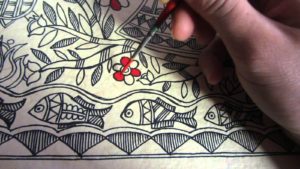
Today, when Mithila painting as an art form is creating livelihood opportunities across the border of India and Nepal, it becomes more imperative than ever to unleash its true potential. Mithila art piques interest in art lovers from different countries like USA, Australia, UK, and Russia.
Patterns from this art form have also found their way onto various items like bags, cushion covers, coasters, mugs, crockery, and mouse pads. More to this it remains ever-popular on the home decor front in the form of prints for table linens, napkin rings, and lamps and most importantly on wall hangings. Mostly because Mithila art was originally used for decorating walls and floors of homes.
The further scope of its exploration is immense, and as it is globally recognized now, its expansion in the course of time will make the women of Mithila drawn towards art entrepreneurship. Much is being done in this regard in Janakpur in Nepal and in Madhubani in India, to prepare for the next round of commercialisation.
[woo-related id=’13004′ show-title=’no’]

